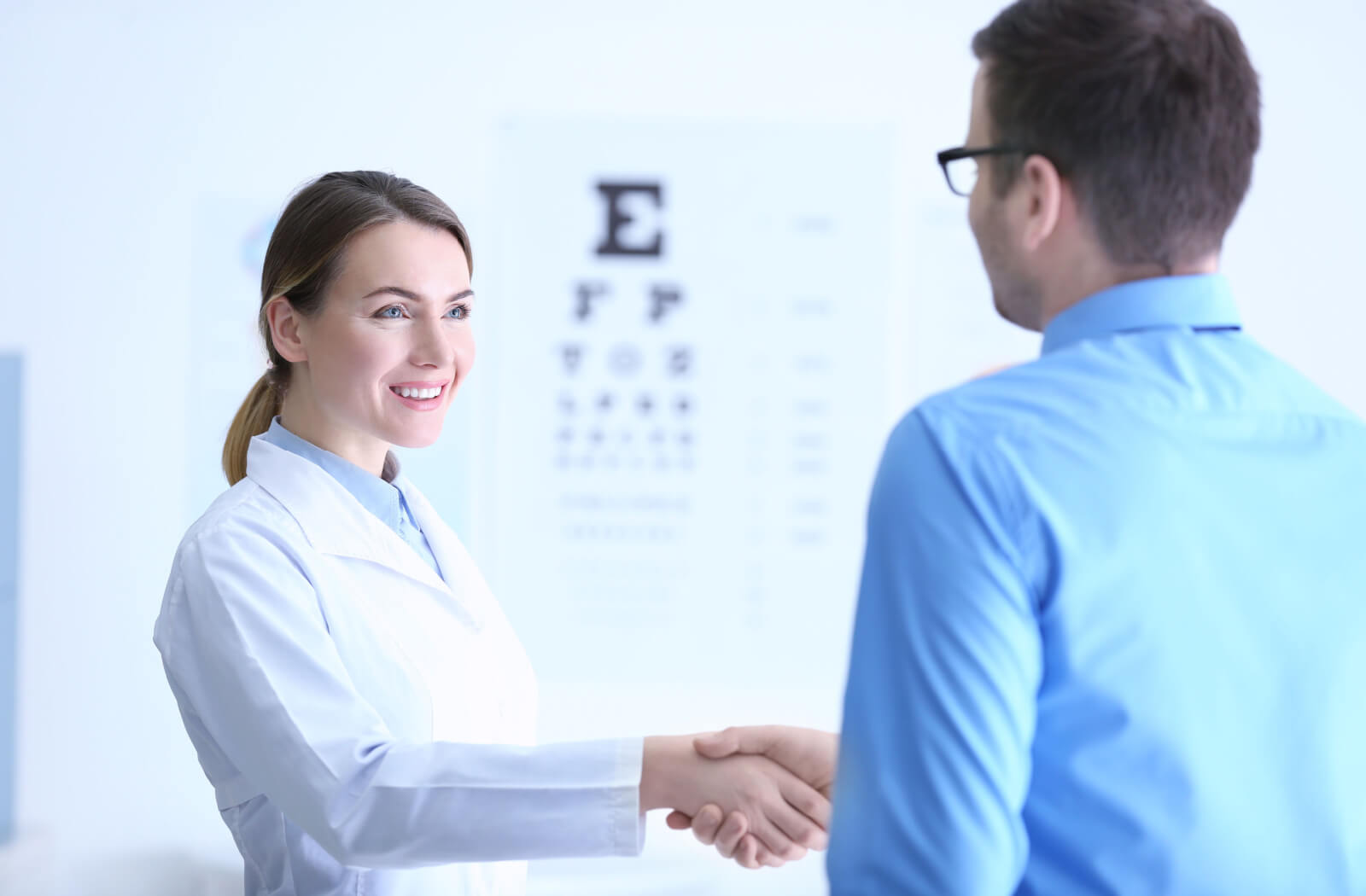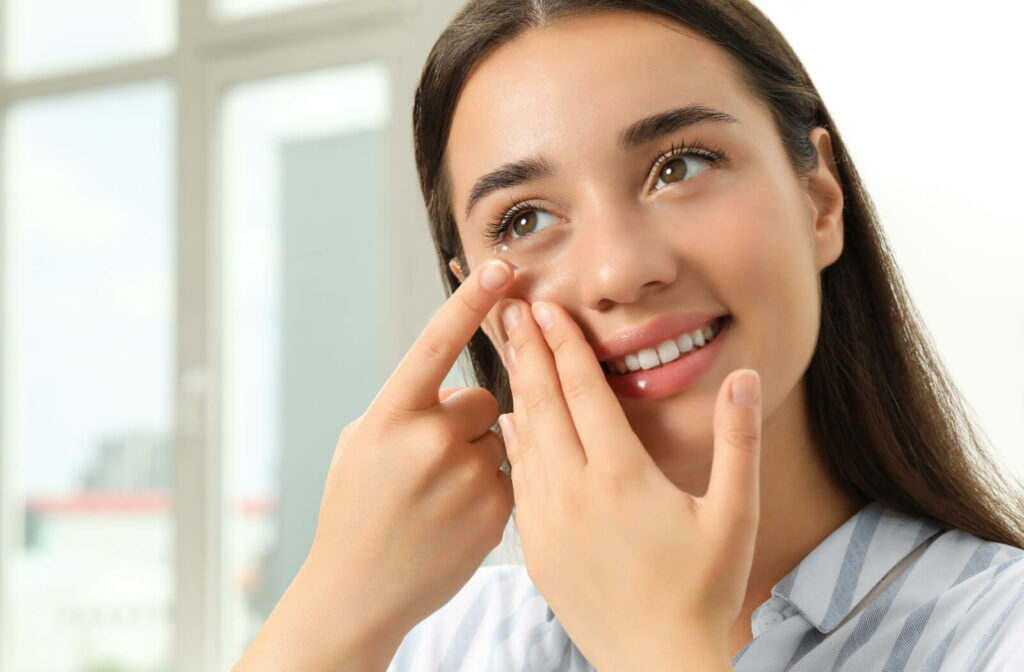Contact lenses are a popular vision option among people who are looking to enjoy frame-free vision. Unlike glasses, contact lenses don’t obstruct your peripheral vision and put no weight on your nose and ears.
To enjoy the full benefits of contact lenses, you need a pair that fits your eyes while supporting your lifestyle. Scheduling a contact lens fitting helps you get the right prescription and type of lens so you can stop worrying and start enjoying the benefits.
What to Expect During a Contact Lens Fitting
Before prescribing you any contact lens, your optometrist gives your eyes a comprehensive checkup. Once they understand what’s going on with your vision, they can get up close and personal with your cornea (that’s the clear dome at the front of your eye). Since the contact lens will sit directly on the front of your eye, it must be measured to find the correct fit.
But don’t worry, we’re not pulling out a tape measure. Instead, we use a device called a keratometer that shines light into your eyes and measures how it bounces back.
The process is fairly simple—it’s like taking a selfie (but with a really bright flash). As the keratometer shines its light through your cornea, it looks for light scattering.
This information helps your optometrist determine what size of contact lenses you need. If we need more info, we can use a corneal topographer to create a detailed map of your eye’s surface. We measure your cornea and use that map to help us identify the size and type of contact lenses your eyes require. We also evaluate your tears, the amount and quality of the tears will determine the type of contact lenses you will be more comfortable with.
Finding the Right Contact Lens for You
There are a variety of contact lenses to choose from. Soft lenses are a popular choice. They’re often comfortable right from the get-go, making them a great option if you’re new to contacts. Soft lenses are available in Monthly, Two-week, or 1 Day Disposable modalities. If you’re all about convenience, daily disposable lenses might be the way to go. No cleaning is required—just throw them in the garbage at the end of the day.
Many types of prescriptions are available in disposable contact lenses from nearsightedness to farsightedness and astigmatism. There are even contacts that are multifocal to help those that need reading glasses. Also, there are contacts that are FDA-approved to control myopia (nearsightedness) in children. Then, there are rigid gas-permeable lenses. While they might take a little longer to get used to, they can offer crisper vision and are more durable.
And if you have specific vision problems, don’t worry. We’ve got specialty contacts like rigid gas permeable lenses and scleral lenses that can cater to your needs.
Contact lenses have been around for decades, and they have certainly come a long way in that time. Today’s contact lenses offer a wide range of options, providing different types of contact lenses to address different needs and lifestyle requirements. There are also contact lenses now for eyes that were once considered too hard to fit.
Soft Contact Lenses
Soft contact lenses are the most popular lens material, with 90% of lens wearers choosing soft lens options for their eyes. They’re made of a flexible plastic that’s good at absorbing water so the lenses stay nice and hydrated. Because of this, many wearers say that soft contact lenses are more comfortable to wear initially.
Sometimes you may hear soft lenses referred to as “disposable lenses” since you typically throw them in the garbage after wearing them.
Rigid Gas-Permeable Contact Lenses
Rigid gas-permeable (RGP) lenses might not be as popular as their soft counterparts, but they offer excellent perks of their own. Made from a hard, oxygen-permeable material, RGP lenses generally offer more crisp vision. They’re also typically more durable and can be easier to handle.
Wearing RGP lenses may take a bit of getting used to and you’ll have to clean them according to the directions outlined by your optometrist since they aren’t disposable.
Daily Disposable Contact Lenses
Daily disposable contact lenses are soft lenses you wear once and then throw away. That means less fuss, no cleaning, no disinfecting, and no storing overnight. If you don’t have the time for a daily lens-cleaning routine, dailies can be a huge help.
With daily disposable lenses, you can use a fresh pair every day and can avoid the risk of infection or irritations caused by accumulated debris on your lenses.
Specialty Contact Lenses
Your eyes are unique, but there are still common vision problems you may share with the larger population. If standard contacts aren’t working for you, your optometrist can suggest specialized lenses.
Scleral Lenses
Here’s the big one—literally! Scleral lenses are larger in diameter than typical lenses and can help people with irregularly shaped corneas, such as those with keratoconus.
Scleral lenses avoid resting on the cornea. Instead, they’re big enough to vault over corneal irregularities, creating a smooth and uniform optical surface. Scleral lenses can also be a great option for people with dry eyes, as the lens holds a reservoir of fluid between the lens and the eye, helping the eye stay hydrated.
Toric Lenses
Toric lenses are designed to correct astigmatism, a common vision problem where the cornea is irregularly shaped. These lenses have different focusing powers vertically and horizontally. Unlike traditional lenses, toric lenses have a defined top and bottom. This makes fitting them correctly even more important, as they need to stay put to work effectively.

Book Your Contact Lens Fitting
You wouldn’t wear shoes a size too small, so why would you wear contacts that don’t fit your eyes? A contact lens fitting is an essential step toward clear vision and safeguarding your eye health. A yearly contact lens fitting is necessary to make sure your eyes are staying healthy, the contact lenses are giving you the best possible vision.The Vision Place team can help simplify the contact lens fitting process for you. You want to see clearer and more comfortably. We want to help you achieve that. Schedule your contact lens fitting, and let us take care of the rest!


